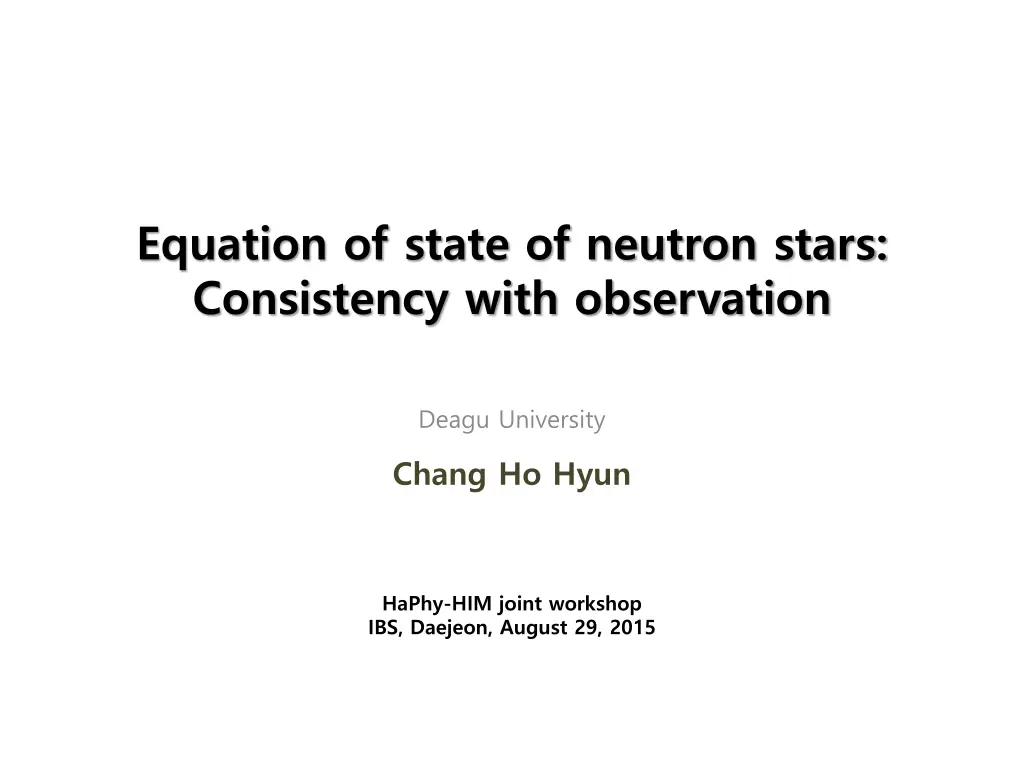
Neutron Star Equation of State and Observational Consistency
Explore the equation of state of neutron stars and its consistency with observations, including mass-radius relationships and cooling mechanisms. Learn about key ingredients, models, and theoretical frameworks in this fascinating field of astrophysics.
Download Presentation

Please find below an Image/Link to download the presentation.
The content on the website is provided AS IS for your information and personal use only. It may not be sold, licensed, or shared on other websites without obtaining consent from the author. If you encounter any issues during the download, it is possible that the publisher has removed the file from their server.
You are allowed to download the files provided on this website for personal or commercial use, subject to the condition that they are used lawfully. All files are the property of their respective owners.
The content on the website is provided AS IS for your information and personal use only. It may not be sold, licensed, or shared on other websites without obtaining consent from the author.
E N D
Presentation Transcript
Equation of state of neutron stars: Consistency with observation Deagu University Chang Ho Hyun HaPhy-HIM joint workshop IBS, Daejeon, August 29, 2015
Contents Observables and current status Model: Skyrme force and RMF Cooling curve Summary Special thanks to: Chang-Hwan Lee (PNU), Kyujin Kwak (UNIST), Yeunhwan Lim (RISP/IBS) and Youngman Kim (RISP/IBS) 2
Observables and current status Mass and radius: binary systems X-ray/optical binaries Double neutron stars White dwarf/neutron stars About 70 systems have been observed Temperature: isolated neutron stars Cooling curve: temperature + age About 20 objects have been measured 4
Mass and radius Key ingredients: equation of state (EoS) Mass distribution (J. Lattimer, Ann. Rev. Nucl. Part., 2012) PSR J1614-2230: (1.97 0.04)M PSR J0348+0432: (2.01 0.04)M 5
Mass-radius (A. Steiner, J. Lattimer, E. Brown, ApJ, 2010): Determine EoS from data set of six neutron stars. Markov chain Monte Carlo algorithm within a Bayesian framework For M = 1.4 M , R = 11 12 km Maximum mass: (1.9 2.2)M 6
Temperature Key ingredients: EoS (particle fraction), Elements in the envelop, Nuclear superfluidity Cas A: Observed about 300 yrs ago Age group - young: less than 104yrs - middle: 104 105yrs - old: more than 105yrs Slow-quick-slow cooling 7
Model Theories 8
Skyrme force General form Mass-radius relation 9
RMF General form Mass-radius relation 10
Cooling curve Cooling mechanism Photon emission: mostly on the surface Neutrino emission: entire region, major energy loss 11
Standard cooling Direct Urca, Modified Urca, Pair bremsstrahlung We do not know the mass of observed stars Probably mass of the stars lie in the canonical range (1.2 1.6)M 12
Skyrme force Mass in the range of (1.0 2.0)M Abrupt drop: ingnition of direct Urca SLy4: do direct Urca Stiffer EoS allows early direct Urca No model can explain middle-age data Good: SLy4, SkI4, SGI TOV-min: fitted to neutron star mass, but does not satisfy cooling 13
RMF Mass in the range of (1.0 2.0)M Abrupt drop: ingnition of direct Urca SFHo: do direct Urca No model can explain middle-age data Good: IU-FSU, DD-Me , SFHo 14
Effect of envelop element Mass range: (1.2 2.0)M Heavy dependence on model 15
Summary Mass-radius and temperature data: experimental constraints Nuclear models: Skyrme force, RMF Could distinguish better models: Good for mass-radius is also good for temperature evolution Proper combination of envelop elements and nuclear superfluidity: prediction within the data More to consider Strangeness - hyperon puzzle - kaon condensation (Y. Lim, K. Kwak, CHH, C.-H. Lee, PRC, 2014) 18
Y. Lim, CHH, K. Kwak, C.-H. Lee, arXiv: 1412.5722, submitted to NPA Cooling curve with strangeness: in progress Improve models: systematic way to determine the EoS at high densities 19
